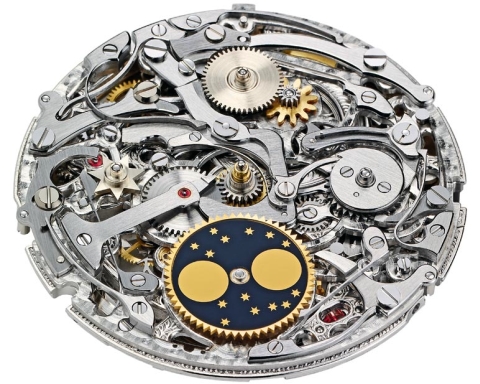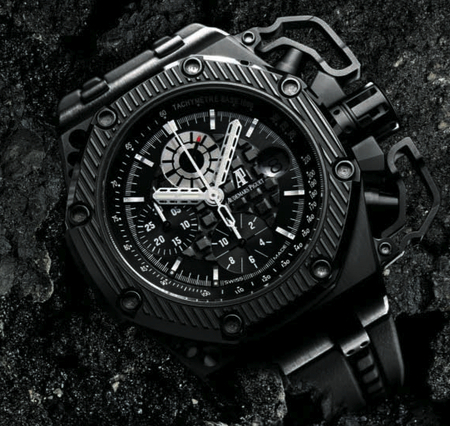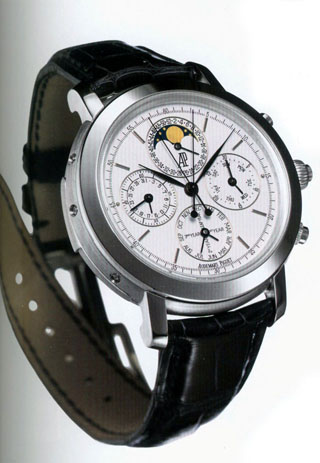Audemars Piguet watch
Today, when young partners embark on a career path, it is often with a steely determination and targeted aims. Some of these partnerships survive through the early years and grow into successful businesses, but the great majority never get past the first excited flushes of the start-up, and quietly dissolve into obscurity. The two young men who in 1875 joined in their pact to manufacture pocketwatches, which would combine quality of build and complexity of function, could have had no idea that almost a century and a half after they set out, their family names would be synonymous with luxury far beyond the reach of all but the highest achievers in business, sport, entertainment and industry.
Jules Audemars and Edward Piguet had attended the same school in Le Brassus in the lush Valée de Joux, then had both trained in different disciplines of the watchmakers craft And so when the two young men recognised the potential of the combination of their individual talents, they were setting in place the cornerstone of one of the worlds’ most famous and respected luxury brands.
Aged only 23 (Audemars) and 21 (Piguet) at the time they began collaborating, the two did not find instant success. They were after all, very young men entering a centuries-old, tradition-steeped craft and one must imagine that it was no easy task for them to achieve the recognition which would see their brand finding the approval of their peers. Indeed it wasn’t until 1882 that Audemars, Piguet & Cie as a trademark was registered. Another seven years before officially founding their company as a manufacture.

But perhaps these facts do not tell the whole story – for by then, in 1889, the Company had been attracting influential clients, such as the Imperial Court of Iran, for a number of years and had their own ‘comptoirs de vente’ in Geneva, Paris, London and New York. So, if some corporate milestones were a while in the making, their client base and sales and distribution channels were already the envy of other older manufactures in the district.
What was bringing the clients in and filling up the order book were the innovative features and complications, such as chiming repeaters – including the worlds’ first minute repeater in wristwatch form in 1892.
By now a manufacture of quite some repute, Audemars, Piguet & Cie. were able to build on their successes, extending their production workshops in Le Brassus to accommodate over seventy of the finest and inventive watchmakers available and bring the entire production process in-house, ensuring that ideas, concepts and quality control remained under one roof. Indeed Audemars Piguet watches and movements were deemed to be of such high quality that the luxury goods ‘houses’ such as Cartier, Tiffany and Bulgari had become important customers for ‘unsigned’ pieces which were then resold with the vendors signature inscribed on the cases and dials.
The coming of war saw a depression in the watch industry and before the world had returned to thinking about the finer things such as Swiss watches, both partners had passed away, Audemars in 1918, Piguet the following year.
Unsurprisingly, the next generation of both families had long been immersed in the art of haut horologie and following the war, each of the founders had a son capable of ensuring the continuity and growth of the company, something which still carries over today in that there has always been a family involvement at the highest level of Audemars Piguet.
It was as if the manufacture never missed a beat. With Paul-Louis Audemars and Paul-Edward Piguet now overseeing the design, manufacture, finances and distribution, a new era of Audemars, Piguet & Co. was seen in with new art deco themed designs which the fashionistas of the day lapped the new pieces up with vigour. The ‘grande dame’ steamed proudly through the roaring twenties.

When the tidal wave of recession and depression hits, it sweeps away all in its path as we are now all too aware, and among the first to feel the impact are the manufacturers and vendors of luxury goods.
As the aftershock of the Wall St Crash in 1929 was felt around the world and economy after economy tumbled into recession, the strong flow of orders swiftly dropped to a trickle, and if stories like that which suggests that in 1932 the workshops manufactured only two pieces, holds any historical fact then it is fair to say that Audemars Piguet had arrived in grand style at rock bottom, along with the other great names in Swiss complications manufactures.
Recovery was going to require downscaling and new ideas, and Audemars Piguet looked to establish new markets. By the end of the 1930s, the manufacture was offering a range of more broadly accessible ‘simple’ complications to compliment their more complex offerings, thereby stimulating the income-stream which was critical to the fanning of the embers of previous successes.
The gathering momentum of the recovery shuddered to a halt with the onset of war in Europe. Again the industry fell upon hard times (allowing of course for the manufacturers of military and aviator timepieces) and many bleak years would pass before the thoughts of the public would return to the finer things in life.
1949 and the Basel Fair. For the first time, Audemars Piguet were present at the major European showcase and the seeds of yet another era were sown.
The 1950s and ‘60s saw a welcome return to prosperity for the marque, and innovation in design and complications combined with greater international distribution through their increased network of importers led to the Audemars Piguet brand consolidating its position among the hierarchy of the great Swiss watch houses.

1962 also saw the positioning of Georges Golay as Business Manager, from where he would go on to become the MD and Chief Executive of the Company in 1966, presiding over the affairs of the brand until 1987, the year in which he passed away.
It was during his tenure that Audemars Piguet would introduce the watch which would truly revolutionize the luxury watch market. The thought that a stainless steel sports watch could merit a place in the high-end sector, never mind find a customer base which would be interested in such a lowly creation, was met with a certain degree of sceptisism from the horological establishment. After all, the sector had hitherto been the rarified preserve of exotic metals and increasingly complex complications.
However when the distinctive new Royal Oak model with its octagonal bezel and eight hexagonal screws and designed by a young Gerald Génta, was presented as a stainless steel ‘simple’ high-end watch, it confounded its critics by selling out of its tentative first release of 1000 pieces. It could be said that it also confounded some at Audemars Piguet as well, as such a departure into a select sector was not much more than a gamble, and by no means were sales guaranteed.
Thirty-seven years on at the time of writing, and the Royal Oak is Audemars Piguets’ most familiar piece, although the introduction of the much larger Royal Oak Offshore in 1992 marked a new direction as it was this model which was to become the iconic statement of style so cherished now by the stars of film, sport and music.

The Royal Oak Offshore, with its’ bold design and usage of materials like rubber, titanium and more recently forged carbon also served to set in stone the marques’ association with high-profile sports and their most illustrious performers.
Having been under the directorship of Georges-Henri Meylan since the passing of his predecessor Georges Golay in 1987, the Offshore was Meylans’ first high-profile product - although it must be said that Audemars Piguet were still crafting and continue to craft, very important complications across an impressive and highly regarded range of models. The Royal Oak Offshore basically eclipsed the other models manufactured by the brand and this remains true today. The other side of the coin is that one of its models has had such a long life and continues to represent the brand so ably and publicly with new, limited edition releases often marking the Audemars Piguet brand association with a sports star (Rubens Barrichello, Juan Pablo Montoya,Shaquille O’Neal etc..) or other high-visibility sporting or cinematic events.
Delve a little deeper into Audemars Piguet and you will find exotic model ranges such as the Millenary and two other models named after both Jules Audemars and Edward Piguet which feature astonishing feats of horology with complications such as the Deadbeat Seconds, the Perpetual Calendar, the Equation of Time, Minute Repeater, Tourbillon and the signature Grande Complication.

So they’ve come a long way those two young men. Long after their own time, their legacy employs over eight hundred people in three manufactures in Le Brassus, Le Locle and Meyrin as well as the brand new Manufacture des Forges facility. Holding true to the earliest tradition, the family-owned Audemars Piguet still oversees the entire manufacturing process in-house and still the incredible complications are being lovingly crafted as they always have been – by hand.
Jules Audemars and Edward Piguet obviously knew what they wanted to achieve when they first began their collaboration, but the scale of their achievements and the reverence in which their surnames are held would certainly not even have been imaginable to them. For without doubt Audemars Piguet is today recognised as one of the very most important watchmakers in the history of the entire industry.
Previous Post: Please also read Luxury watches by Armand Nicolet
